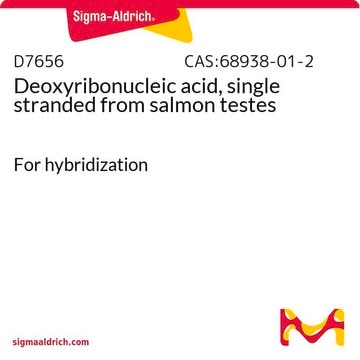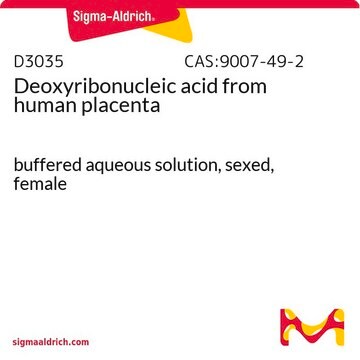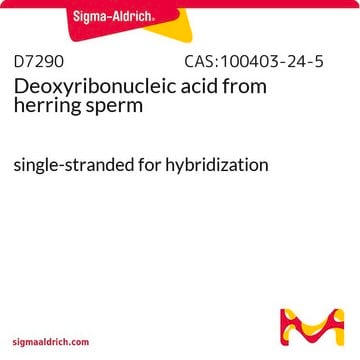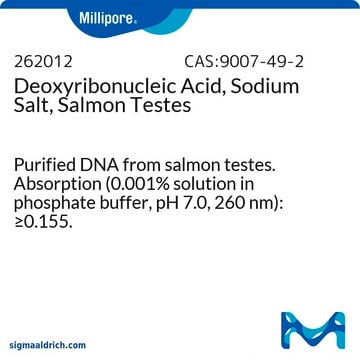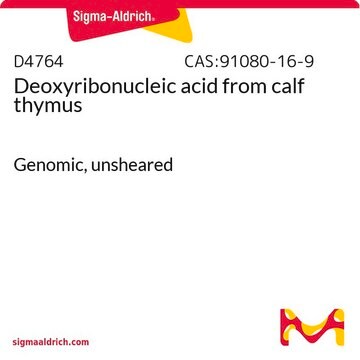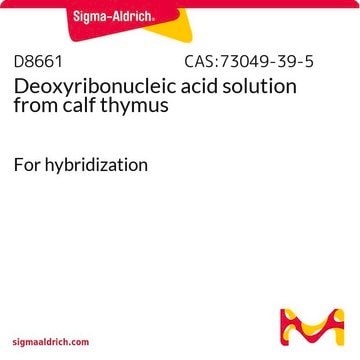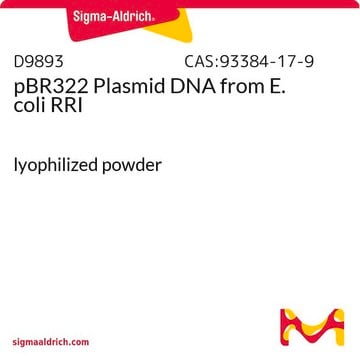D4889
Deoxyribonucleic acid sodium salt from Escherichia coli strain B
Genomic, unsheared
Synonym(s):
DNA
Sign Into View Organizational & Contract Pricing
All Photos(1)
About This Item
CAS Number:
EC Number:
MDL number:
UNSPSC Code:
41106310
eCl@ss:
32160414
NACRES:
NA.52
Recommended Products
Looking for similar products? Visit Product Comparison Guide
Related Categories
General description
Escherichia coli strain B is most widely studied DNA after k-12. The genomes of E coli strain B and k-12 show differences in the IS sequence elements. Strain B have B-islands and express O-specific side-chain LPS. The product is unsheared genomic DNA.
Specificity
50% GC; Tm = 90.5 °C
Application
The DNAs are particularly useful for genomic analysis, including PCR, library construction in bacteriophage λ, and in heterologous pre-hybridization and hybridization protocols.
Deoxyribonucleic acid sodium salt from Escherichia coli strain B has been used for:
Deoxyribonucleic acid sodium salt from Escherichia coli strain B has been used for:
- PCR reactions of genomic DNA of Gardnerella vaginalis
- nick translation and radiolabeling of dNTP
- generating standard curve for 16S rDNA quantification
- transfecting neutrophils
- testing the extraction methods
Unit Definition
One unit will yield an A260 of 1.0 in 1.0 ml of 1 mM Tris-HCl, pH 7.5, with 1 mM NaCl and 1 mM EDTA (1 cm light path).
Preparation Note
Purified by anion exchange chromatography, dialyzed against a solution of 1 mM sodium chloride, 1 mM EDTA and 1 mM Trizma HCl, pH 7.5 and lyophilized at a concentration of approx. 2 units per mL. Approx. 20 A260 units per mg DNA. % GC is the percentage of G/C base pairs. Tm is the temperature at the midpoint of the thermal denaturation profile.
Analysis Note
Analyzed by gel electrophoresis and visualization after ethidium bromide staining, with single predominant band of 45 kB or greater.
Other Notes
DNA in solution will reanneal on standing at room temperature so it is recommended to boil the solution for 10 minutes and then cool on ice for at least 5 minutes prior to use.
related product
Product No.
Description
Pricing
Storage Class Code
11 - Combustible Solids
WGK
WGK 3
Flash Point(F)
Not applicable
Flash Point(C)
Not applicable
Personal Protective Equipment
dust mask type N95 (US), Eyeshields, Gloves
Certificates of Analysis (COA)
Search for Certificates of Analysis (COA) by entering the products Lot/Batch Number. Lot and Batch Numbers can be found on a product’s label following the words ‘Lot’ or ‘Batch’.
Already Own This Product?
Find documentation for the products that you have recently purchased in the Document Library.
Customers Also Viewed
M Agarwal et al.
BJU international, 88(9), 868-870 (2002-02-20)
To investigate the possible role of Gardnerella vaginalis in interstitial cystitis (IC), using molecular methods to avoid difficulties with the culture and recovery of viable organisms, and the problems associated with the recovery of low numbers of culturable organisms. Thirty-three
Yue Huo et al.
Current microbiology, 76(1), 22-28 (2018-11-02)
A Gram-positive bacterium (DCY118T) was isolated from ginseng-cultivated soil in Gochang-gun, Republic of Korea. This isolate was assigned to the genus Ornithinimicrobium and is closely related to Ornithinimicrobium kibberense K22-20T (98.8%), O. pekingense DSM 21552T (98.5%), O. algicola JC311T (98.2%)
Joseph W Duris et al.
Water research, 47(1), 300-314 (2012-11-15)
The occurrence and distribution of fecal indicator bacteria (FIB) and bacterial and protozoan pathogens are controlled by diverse factors. To investigate these factors in Pennsylvania streams, 217 samples were collected quarterly from a 27-station water-quality monitoring network from July 2007
S Farzaneh et al.
The Journal of antimicrobial chemotherapy, 40(6), 789-795 (1998-02-14)
Klebsiella oxytoca strain HB60 is highly resistant to cefoperazone and aztreonam (MICs = 128 mg/L). It produces a chromosomally encoded beta-lactamase of pI 5.7 which was highly efficient against penicillins, first-generation cephalosporins and cefoperazone, a non-oxyimino third-generation cephalosporin. Aztreonam and
Genomic comparisons among Escherichia coli strains B, K-12, and O157: H7 using IS elements as molecular markers
Schneider D, et al.
BMC Microbiology, 2(1), 18-18 (2002)
Our team of scientists has experience in all areas of research including Life Science, Material Science, Chemical Synthesis, Chromatography, Analytical and many others.
Contact Technical Service
